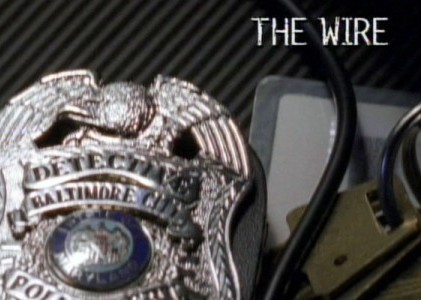Extra Credit, Part 2
Making The Wire, Museum of the Moving Image, July 30, 2008
This video essay is part of a series on The Wire. Also on Moving Image Source: Dana Polan on the show's Balzacian universe, Nelson George on its complex portrayal of black America, David Schwartz on its view of life as a chess game, and video essays on the Season 1, Season 3, Season 4, and Season 5 credits by Andrew Dignan, Kevin B. Lee, and Matt Zoller Seitz.
The following text is the voiceover script for the video essay on The Wire's Season 2 credits.
In contrast to the darkened corners and nighttime crime scenes, many of which are imported from Season 1's credits, most of the shots in the credits for Season 2 of The Wire are in plain daylight. This is a concession to the fact that stevedores don't offload ships at night, but the sunlit frankness of these images serves as a metaphor as well. There's an impunity with which these men bend the law; they operate in plain sight.
Are those who enable the infrastructure of the drug trade any less culpable than those who package and distribute the product? Less a procedural and more of a tragedy, the second season of The Wire creates a dilemma for viewers. Just as the corner boys are a creation of circumstance and their environment, we can't help but sympathize with union leader Frank Sobotka's fall from grace. He's a byproduct of a society that prizes economy and speed over honest labor and professional know-how. The music that plays underneath the sequence is the original recorded version of "Way Down in the Hole," sung by its writer, Tom Waits—a bluesy dirge that you might hear playing on a jukebox frequented by one of the show's blue-collar dockworkers. The credits introduce the idea that getting hammered at your local pub is merely the condoned flip-side of pushing off in an abandoned building; the crimes of the unions are considered more socially acceptable than selling drugs.
It's a season in which personal attachments bring about downfall, whether it's the destruction of the union brought about by Major Valchek's animosity toward Sobotka, or Sobotka's own death being a direct result of trying to save the life of his son, Ziggy, or the blond woman we see, the girlfriend of Sobotka's nephew, Nicky, placing pressure on the young man for financial security that leads to the quick fix that comes with the criminal lifestyle.
The sequence also hints at the affair between Stringer Bell and the girlfriend of D'Angelo Barksdale, which will bring about the death of both men. The image of Stringer Bell unzipping a woman's jacket will be repeated in the opening credits of Season 3, when his particular story is resolved. —A.D. ![]()
LATEST ARTICLES
-20140814-173707-thumb3.jpg)
Fighting Words
by Imogen Sara Smith
posted August 12, 2014

Fighting Words, Part 2
by Imogen Sara Smith
posted August 20, 2014

On the Margins: The Fil…
by Andrew Chan
posted August 12, 2014

Robin Williams: A Sense…
by David Schwartz
posted August 12, 2014
 The Wire's Season 2 credits
The Wire's Season 2 credits
RELATED ARTICLE
Extra Credit, Part 1 by Andrew Dignan, Kevin B. Lee and Matt Zoller SeitzExtra Credit, Part 3 by Andrew Dignan, Kevin B. Lee and Matt Zoller Seitz
Extra Credit, Part 4 by Andrew Dignan, Kevin B. Lee and Matt Zoller Seitz
Extra Credit, Part 5 by Andrew Dignan, Kevin B. Lee and Matt Zoller Seitz
Invisible City by Dana Polan
Across Racial Lines by Nelson George
Kings and Pawns by David Schwartz
More: Article Archive
THE AUTHORS
Andrew Dignan is a film producer and occasional blogger living in Los Angeles. His last film, the Sundance selection Steel City, is now on DVD and he is currently in pre-production on two features and a short scheduled to shoot this fall.
More articles by Andrew DignanKevin B. Lee is editor of the Keyframe journal at Fandor and programming executive at dGenerate Films.
More articles by Kevin B. LeeMatt Zoller Seitz is a writer and filmmaker whose debut feature, the romantic comedy Home, is available through Netflix and Amazon. His writing on film and television has appeared in The New York Times, New York Press, and The Star Ledger, among other places. He is also the founder of The House Next Door, a movie and TV criticism website.
More articles by Matt Zoller SeitzAuthor's Website: The House Next Door

